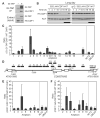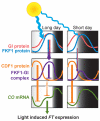FKF1 and GIGANTEA complex formation is required for day-length measurement in Arabidopsis
- PMID: 17872410
- PMCID: PMC3709017
- DOI: 10.1126/science.1146994
FKF1 and GIGANTEA complex formation is required for day-length measurement in Arabidopsis
Abstract
Precise timing of CONSTANS (CO) gene expression is necessary for day-length discrimination for photoperiodic flowering. The FLAVIN-BINDING, KELCH REPEAT, F-BOX 1 (FKF1), and GIGANTEA (GI) proteins regulate CO transcription in Arabidopsis. We demonstrate that FKF1 and GI proteins form a complex in a blue-light-dependent manner. The timing of this interaction regulates the timing of daytime CO expression. FKF1 function is dependent on GI, which interacts with a CO repressor, CYCLING DOF FACTOR 1 (CDF1), and controls CDF1 stability. GI, FKF1, and CDF1 proteins associate with CO chromatin. Thus, the FKF1-GI complex forms on the CO promoter in late afternoon to regulate CO expression, providing a mechanistic view of how the coincidence of light with circadian timing regulates photoperiodic flowering.
Figures




Comment in
-
Plant science. Standing on the shoulders of GIGANTEA.Science. 2007 Oct 12;318(5848):206-7. doi: 10.1126/science.1150213. Science. 2007. PMID: 17932276 No abstract available.
References
Publication types
MeSH terms
Substances
Grants and funding
LinkOut - more resources
Full Text Sources
Other Literature Sources
Molecular Biology Databases

